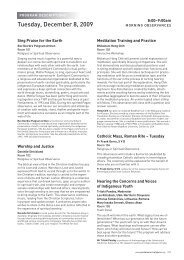Whispers and Vanities in Samoan Indigenous Religious Culture
Whispers and Vanities in Samoan Indigenous Religious Culture
Whispers and Vanities in Samoan Indigenous Religious Culture
You also want an ePaper? Increase the reach of your titles
YUMPU automatically turns print PDFs into web optimized ePapers that Google loves.
The god of this Tagaloa government was believed to be the Supreme God Tagaloa.<br />
His earthly manifestation, whose chiefly title was Tagaloa, was head of this earthly<br />
regime <strong>in</strong> Uafato. The ancient <strong>Samoan</strong>s who subscribed to the Tagaloa tradition<br />
would go to Uafato to pay homage. This <strong>in</strong>volved say<strong>in</strong>g prayers, fast<strong>in</strong>g <strong>and</strong><br />
meditat<strong>in</strong>g at each of the n<strong>in</strong>e prayer mounds (known <strong>in</strong> <strong>Samoan</strong> as lagi) located at<br />
different levels up the mounta<strong>in</strong>, start<strong>in</strong>g near the bottom. There were n<strong>in</strong>e such<br />
prayer mounds represent<strong>in</strong>g n<strong>in</strong>e heavens or places of spiritual engagement. These<br />
prayer mounds served as places of worship around which a community of people<br />
settled, most of whom were adherents of the Tagaloa religion. When worshippers<br />
walked from one mound to the next they would acknowledge through prayer the<br />
different stages of creation, as recorded <strong>in</strong> the Tagaloa auala or funeral chant. 20 It<br />
was believed that on death the spirit of a person would travel the auala or pathway up<br />
this mounta<strong>in</strong> towards the n<strong>in</strong>th heaven or lagi 21 . If the deceased had achieved dur<strong>in</strong>g<br />
his/her lifetime each of the levels of spirituality required to enter each heaven, they<br />
would proceed through until they reached the n<strong>in</strong>th heaven, their f<strong>in</strong>al dest<strong>in</strong>ation.<br />
The tenth heaven where God Tagaloa resided was beyond the n<strong>in</strong>th heaven, beyond<br />
the earthly mounta<strong>in</strong>, <strong>in</strong>to the cosmos <strong>and</strong> the realm of the unknowable. In life <strong>and</strong><br />
death the tenth heaven was considered beyond man’s reach. This thesis on the<br />
spiritual <strong>and</strong> temporal realms of human life was part of Uafato <strong>in</strong>digenous history <strong>and</strong><br />
implicit <strong>in</strong> their religious chants, <strong>in</strong>clud<strong>in</strong>g their medic<strong>in</strong>al <strong>in</strong>cantations.<br />
The laoa chant of a Ti’avea taulasea provides the last example of heal<strong>in</strong>g practices.<br />
The significance of this chant is that unlike the other three chants, this one provides<br />
clear evidence of the character of the religious duality experienced by <strong>Samoan</strong>s today,<br />
where there is an explicit jo<strong>in</strong><strong>in</strong>g of their Christian <strong>and</strong> <strong>in</strong>digenous religious beliefs,<br />
even if somewhat awkward.<br />
In this treatment the Ti’avea taulasea would ask his patient to face seaward, fan his or<br />
her face <strong>and</strong> then chant:<br />
Folo, oi Folo e, ia e alofa mai<br />
O Pai ua laoa i le ivi o le mu<br />
O Iesu o le taulasea,<br />
O Iesu e maua ai le fofo<br />
Ia e alofa mai.<br />
Folo, oh Folo, have pity<br />
Pai is chok<strong>in</strong>g on the bone of a mu fish<br />
Jesus is the Physician, Jesus will cure him<br />
Have pity.<br />
After the chant the fishbone would usually have dislodged itself.<br />
The religious <strong>and</strong> cultural underp<strong>in</strong>n<strong>in</strong>gs of the healer’s medic<strong>in</strong>al knowledge are<br />
apparent with<strong>in</strong> the traditional treatment of this relatively straightforward <strong>and</strong><br />
common ailment. The treatment of laoa provides a helpful example not only of how<br />
<strong>in</strong>digenous religious beliefs are embedded <strong>and</strong> embodied <strong>in</strong> traditional <strong>Samoan</strong><br />
heal<strong>in</strong>g practices – the ma<strong>in</strong> casualty of the culture of whispers – but how religion<br />
20<br />
21<br />
See a full account of this Tagaloa funeral chant <strong>in</strong> Tui Atua (2009a, p.155).<br />
The term lagi is used to describe a spiritual heaven <strong>and</strong> a place of worship.<br />
11











